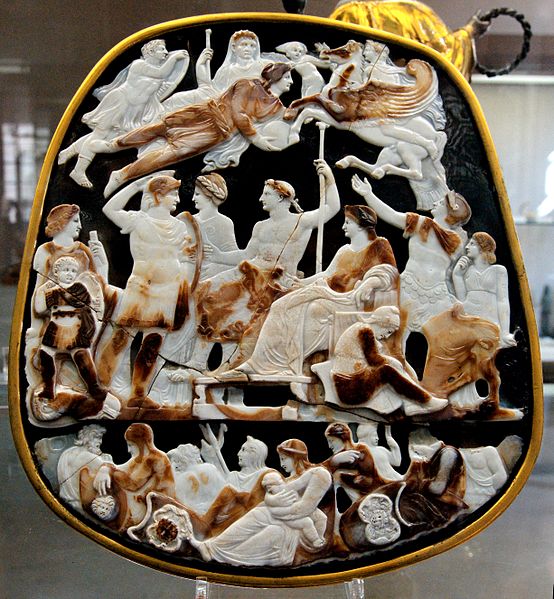Cameo is a method of carving an object such as an engraved gem, item of jewellery or vessel. It nearly always features a raised (positive) relief image; contrast with intaglio, which has a negative image. Originally, and still in discussing historical work, cameo only referred to works where the relief image was of a contrasting colour to the background; this was achieved by carefully carving a piece of material with a flat plane where two contrasting colours met, removing all the first colour except for the image to leave a contrasting background.
The Great Cameo of France, five layers sardonyx, Rome, c. 23 AD, the largest of Antiquity
Eagle Cameo, Roman 27 B.C. Two-layered onyx.
Cameo of Roman Emperor Augustus wearing a gorgoneion and a sword-belt. Three-layered sardonyx cameo, Roman artwork, c. 14–20 AD.
Woman wearing a cameo at her throat, on a high lace collar in the Edwardian style
An engraved gem, frequently referred to as an intaglio, is a small and usually semi-precious gemstone that has been carved, in the Western tradition normally with images or inscriptions only on one face. The engraving of gemstones was a major luxury art form in the ancient world, and an important one in some later periods.
Roman intaglio portrait of Caracalla in amethyst, once in the Treasury of Sainte-Chapelle. At some point it was adapted by adding an inscription and cross to represent Saint Peter
Relief cameo of a Roman prince. Perhaps 14th century.
Antelopes attacked by birds: cylinder seal in hematite and its impression. Late Bronze Age II (maybe 14th century BC), from Cyprus in the Minoan period, following Near Eastern precedents.
Reclining satyr, Etruscan c. 550 BC, 2.2 cm wide. Note the vase shown "sideways"; it is characteristic of early gems that not all elements in the design are read from the same direction of view.








